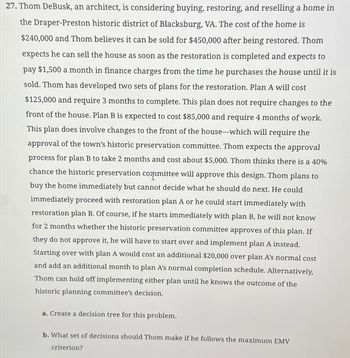
FINANCIAL ACCOUNTING
10th Edition
ISBN: 9781259964947
Author: Libby
Publisher: MCG
expand_more
expand_more
format_list_bulleted
Question
Answering all questions compulsory....

Transcribed Image Text:27. Thom DeBusk, an architect, is considering buying, restoring, and reselling a home in
the Draper-Preston historic district of Blacksburg, VA. The cost of the home is
$240,000 and Thom believes it can be sold for $450,000 after being restored. Thom
expects he can sell the house as soon as the restoration is completed and expects to
pay $1,500 a month in finance charges from the time he purchases the house until it is
sold. Thom has developed two sets of plans for the restoration. Plan A will cost
$125,000 and require 3 months to complete. This plan does not require changes to the
front of the house. Plan B is expected to cost $85,000 and require 4 months of work.
This plan does involve changes to the front of the house-which will require the
approval of the town's historic preservation committee. Thom expects the approval
process for plan B to take 2 months and cost about $5,000. Thom thinks there is a 40%
chance the historic preservation committee will approve this design. Thom plans to
buy the home immediately but cannot decide what he should do next. He could
immediately proceed with restoration plan A or he could start immediately with
restoration plan B. Of course, if he starts immediately with plan B, he will not know
for 2 months whether the historic preservation committee approves of this plan. If
they do not approve it, he will have to start over and implement plan A instead.
Starting over with plan A would cost an additional $20,000 over plan A's normal cost
and add an additional month to plan A's normal completion schedule. Alternatively,
Thom can hold off implementing either plan until he knows the outcome of the
historic planning committee's decision.
a. Create a decision tree for this problem.
b. What set of decisions should Thom make if he follows the maximum EMV
criterion?
Expert Solution
This question has been solved!
Explore an expertly crafted, step-by-step solution for a thorough understanding of key concepts.
This is a popular solution
Trending nowThis is a popular solution!
Step by stepSolved in 5 steps

Knowledge Booster
Similar questions
arrow_back_ios
arrow_forward_ios
Recommended textbooks for you

 AccountingAccountingISBN:9781337272094Author:WARREN, Carl S., Reeve, James M., Duchac, Jonathan E.Publisher:Cengage Learning,
AccountingAccountingISBN:9781337272094Author:WARREN, Carl S., Reeve, James M., Duchac, Jonathan E.Publisher:Cengage Learning, Accounting Information SystemsAccountingISBN:9781337619202Author:Hall, James A.Publisher:Cengage Learning,
Accounting Information SystemsAccountingISBN:9781337619202Author:Hall, James A.Publisher:Cengage Learning, Horngren's Cost Accounting: A Managerial Emphasis...AccountingISBN:9780134475585Author:Srikant M. Datar, Madhav V. RajanPublisher:PEARSON
Horngren's Cost Accounting: A Managerial Emphasis...AccountingISBN:9780134475585Author:Srikant M. Datar, Madhav V. RajanPublisher:PEARSON Intermediate AccountingAccountingISBN:9781259722660Author:J. David Spiceland, Mark W. Nelson, Wayne M ThomasPublisher:McGraw-Hill Education
Intermediate AccountingAccountingISBN:9781259722660Author:J. David Spiceland, Mark W. Nelson, Wayne M ThomasPublisher:McGraw-Hill Education Financial and Managerial AccountingAccountingISBN:9781259726705Author:John J Wild, Ken W. Shaw, Barbara Chiappetta Fundamental Accounting PrinciplesPublisher:McGraw-Hill Education
Financial and Managerial AccountingAccountingISBN:9781259726705Author:John J Wild, Ken W. Shaw, Barbara Chiappetta Fundamental Accounting PrinciplesPublisher:McGraw-Hill Education


Accounting
Accounting
ISBN:9781337272094
Author:WARREN, Carl S., Reeve, James M., Duchac, Jonathan E.
Publisher:Cengage Learning,

Accounting Information Systems
Accounting
ISBN:9781337619202
Author:Hall, James A.
Publisher:Cengage Learning,

Horngren's Cost Accounting: A Managerial Emphasis...
Accounting
ISBN:9780134475585
Author:Srikant M. Datar, Madhav V. Rajan
Publisher:PEARSON

Intermediate Accounting
Accounting
ISBN:9781259722660
Author:J. David Spiceland, Mark W. Nelson, Wayne M Thomas
Publisher:McGraw-Hill Education

Financial and Managerial Accounting
Accounting
ISBN:9781259726705
Author:John J Wild, Ken W. Shaw, Barbara Chiappetta Fundamental Accounting Principles
Publisher:McGraw-Hill Education